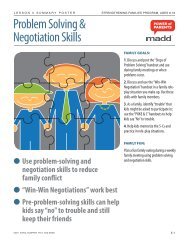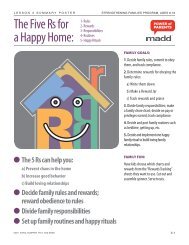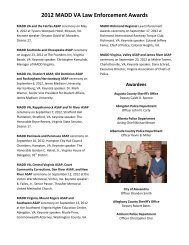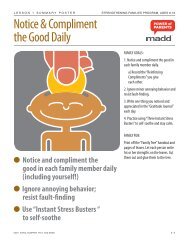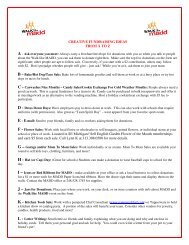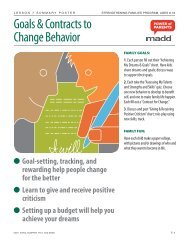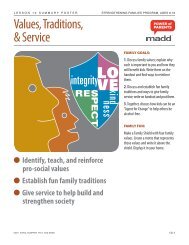Alcohol, Tobacco or Other Drugs (A.T.O.D.) - MADD
Alcohol, Tobacco or Other Drugs (A.T.O.D.) - MADD
Alcohol, Tobacco or Other Drugs (A.T.O.D.) - MADD
- No tags were found...
Create successful ePaper yourself
Turn your PDF publications into a flip-book with our unique Google optimized e-Paper software.
LESSON 8 STRENGTHENING FAMILIES PROGRAM, AGES 8-16Keeping Kids <strong>Alcohol</strong> and Drug FreeUse these six proven skills drawn from research and experience1. BELIEVE INYOUR INFLUENCEAS A PARENT• Kids say parents are the biggest influencein their lives—m<strong>or</strong>e than peers• Kids say parental disapproval of drinkingis the #1 reason they don’t drink• Parents influence kids not to drinkwhen they bond, set clear “no-alcohol”rules, and monit<strong>or</strong> activities4. BOND WITHYOUR KIDS• Express love, empathy, appreciation• Speak respectfully; make time to chat• Eat dinner together, share values• Be involved in their lives and activities;encourage good school perf<strong>or</strong>mance• PLAY!!! One-on-one “My-Time” dailyTry saying this: “You mean m<strong>or</strong>e tome than anything else in the w<strong>or</strong>ld.I’d really be sad if you drank <strong>or</strong> useddrugs and limited your futurehappiness.”2. TEACH HOWALCOHOL HARMSTEEN BRAIN• Brain is not fully developed until midtwenties;alcohol harms thedeveloping brain• Impairs “white matter” f<strong>or</strong>mation• Harms prefrontal c<strong>or</strong>tex—goodjudgment, impulse-control center• Harms pleasure-reward center,creating high risk of addiction• Harms hippocampus—learning andmem<strong>or</strong>y center; 10% smaller in drinkers• Illegal drugs and misuse of prescriptiondrugs also harm the developing brain5. SET BOUNDARIES• Make a firm no alcohol, tobacco, <strong>or</strong>drugs rule• Establish firm, fair consequences; thenenf<strong>or</strong>ce consistently if rules broken• Kids must leave party if alcohol there• Make a firm “no riding with driver whohas been drinking” rule• Practice “refusal skills” using the “5-Cs”Try saying this: “Because we loveyou so much, we have made a firm, ‘nousing any alcohol bef<strong>or</strong>e age 21’ rule;and no tobacco <strong>or</strong> drug use, includingother peoples’ prescription drugs.’We prefer you not hang out with kidswho do use.”3. KNOW WHYKIDS DRINK ANDWHAT TO DOKids drink because:• Exposure to alcohol makes them thinkdrinking will be pleasurable• Impulsive; risk-taking, thrill-seeking• Immature judgment: “drunk is fun”• B<strong>or</strong>ed; “nothing else fun to do”• Stressed; need ways to relax• Unhappy; want to escape• Peer pressure; want to fit in• Want to rebel <strong>or</strong> appear grown-up• Genetic predisposition; e.g. children ofalcoholics; mental dis<strong>or</strong>ders• Easy alcohol access, availability3 essential skills to prevent drinking:• Bonding, Boundaries, and Monit<strong>or</strong>ing6. MONITOR• Lock-up your liqu<strong>or</strong> and beer; limitaccess to your prescription drugs• Know who kids are with, what they aredoing at all times (always ask 5-Ws)• Get to know your kids’ friends’ parents;discuss your no-alcohol rules• Make sure kids are supervised whennot in school and parents are gone• Monit<strong>or</strong> plans and parties to make surekids stay in alcohol-free activities• Help plan fun no-alcohol activitiesTry saying this: “We want to gettogether with your friends and theirparents, to plan fun no-alcoholactivities.”©2011 KAROL KUMPFER, PH.D. AND <strong>MADD</strong> 8-2
LESSON 8 STRENGTHENING FAMILIES PROGRAM, AGES 8-16<strong>Alcohol</strong> Harms a Teen’s Developing BrainKnowledge is power. Share these alcohol facts with your kidsNew research shows that alcohol affects a teen’s developing brain differently than a mature adult brain. It can harm “white matter “f<strong>or</strong>mation, good judgment,mem<strong>or</strong>y, mental health, and greatly increase the risk of alcoholism. Share these facts with your kids, have them commit to stay alcohol-free until at least agetwenty-one, and sign the “<strong>Alcohol</strong>-Free Pledge.”“The brain goes through dynamic change during adolescence, and alcohol can seriously damage long-and sh<strong>or</strong>t-term growth processes.”–American Medical Association Fact Sheet, 2003; http://www.ama-assn.<strong>or</strong>g/ama/no-index/physician-resources/9416.shtmlPrefrontal Damage(Good judgment area) “Adolescentdrinking could cause severe changes inthis area...which plays an imp<strong>or</strong>tant role inf<strong>or</strong>ming adult personality and behavi<strong>or</strong>...”(AMA Fact Sheet 2003)HippocampusDamage“The hippocampus suffers from thew<strong>or</strong>st alcohol-related brain damagein teens. Heavy teen drinkers had...10% smaller hippocampi.”(AMA Fact Sheet 2003)<strong>Alcohol</strong> Can“Wire” A Teen’sBrain F<strong>or</strong>AddictionPercent of Prevalence50454035302520151050Age 13 14 15 16 17 18 19 20 21Grant, BF and Dawson, DA. Journal of Substance Abuse 9:103-110. 1997Altered Pleasure-Motivation System<strong>Alcohol</strong> alters the brain so it gives a pleasure response to a harmfulchemical instead of a real experience. http://www.associatedcontent.com/article/5704898/addictions_alter_the_pleasure_center.html?cat=545 percent ofkids who begindrinking at agethirteen willbecome alcoholdependentOnly 7 percentof those whobegin drinking atage twenty-onebecome alcoholicsWhite MatterDamageIn MRI studies by Dr. Susan Tapert,binge drinking teens showedstructural damage to the whitematter throughout the brain—which helps transmit brain signals.http://www.npr.<strong>or</strong>g/templates/st<strong>or</strong>y/st<strong>or</strong>y.php?st<strong>or</strong>yId=122765890ImpairedMem<strong>or</strong>y andLearning“Sh<strong>or</strong>t term <strong>or</strong> moderatedrinking impairs learning andmem<strong>or</strong>y far m<strong>or</strong>e in youth thanadults.” (AMA fact sheet 2003)M<strong>or</strong>e Troubles With Teens and <strong>Alcohol</strong>• <strong>Alcohol</strong> poisoning: Brain cut-off switch under-developed, allows teens todrink dangerous amounts; can die if pass-out with alcohol still in stomach• Increased illegal drug use among teen drinkers• Increase in youth suicide attempts (In eighth grade girls, 37 percent ofheavy drinkers attempted suicide versus 11 percent of non-drinkers)• Increase in teen pregnancies, STDs, Fetal <strong>Alcohol</strong> Syndrome babies• “The younger adolescents are when they start to drink, the m<strong>or</strong>e likelythey are to engage in risky behavi<strong>or</strong>s including promiscuity, doing drugsand earning po<strong>or</strong> grades...” (NIH, NIAAA publication # 67, Jan. 2006)• Brain altered in heavy teen drinkers to react positively to alcohol ads.(fMRI’s show high brain “cue reactivity” to visual images of alcohol advertisingvs. no response in non-drinking teens; meaning the brain is nowprogrammed to respond to alcohol advertisements) http://www.csamasam.<strong>or</strong>g/pdf/misc/_Brown_-_Neural_Response_to_Alc_in_Adol.pdf• When kids drink, their brains’ ability to care if they make a mistake issurpressed.©2011 KAROL KUMPFER, PH.D. AND <strong>MADD</strong> 8-3
LESSON 8 STRENGTHENING FAMILIES PROGRAM, AGES 8-16The 5-Cs to Stay Smart and SafeA smart way to say “no” and still keep your friendsautionAsk questionsool itName the negativebehavi<strong>or</strong> and say “no”hange the planSuggest a better ideaatch you laterall meLeave if necessaryCall me if you change your mind©2011 KAROL KUMPFER, PH.D. AND <strong>MADD</strong> 8-4
LESSON 8 STRENGTHENING FAMILIES PROGRAM, AGES 8-16Family Protective StrategiesUse these to protect your children from <strong>Alcohol</strong>, <strong>Tobacco</strong>, and <strong>Other</strong> <strong>Drugs</strong>Below are bonding, boundaries, and monit<strong>or</strong>ing strategies that help protect kids from A.T.O.D. use. Put an “X” by the ones you already do; circle the onesyou’d like to w<strong>or</strong>k on. Make a plan and start out small. Add new ones as the old ones become a habit.BONDINGWe spend 10-15 minutes of one-on-one “My Time” with each child almost every day.We make a point to notice and compliment the good in each family member.We have weekly family meetings.We eat together as a family at least three times a week.We spend time together as a family doing fun things.We go to school activities such as games and perf<strong>or</strong>mances as a family.We talk often to our children about their dreams and goals.We keep up positive family customs and traditions.BOUNDARIESWe encourage and supp<strong>or</strong>t school w<strong>or</strong>k, and we have set times to do homew<strong>or</strong>k.We have family rules that are fair and consistently enf<strong>or</strong>ced.We divide household ch<strong>or</strong>es among family members.We talk about our standards related to no alcohol, tobacco, <strong>or</strong> drug use; and we have a rule that if alcohol <strong>or</strong> drugs show up at aparty, they are to call us and come home.We have rules (curfew) f<strong>or</strong> each kid about what time to be home.We encourage our kids to participate in activities that promote a positive sense of self.We help our children develop skills in goal-setting, communication, decision-making, and conflict resolution.MONITORINGWe find out where our children are going, who they’ll be with, what they’ll be doing, and when they’ll be home.We get to know our kids’ friends’ parents and share our no A.T.O.D. rules.We see that our kids stay in an alcohol and drug free social environment.We make sure our children don’t have access to our alcohol <strong>or</strong> prescription drugs.We promote fun, positive alternative activities to teen alcohol and drug use.©2011 KAROL KUMPFER, PH.D. AND <strong>MADD</strong> 8-5
LESSON 8 STRENGTHENING FAMILIES PROGRAM, AGES 8-16Freedom Pledge to Never Drink and DriveNo excuses. Make a personal pledge and keep itI PLEDGEALCOHOL IMPAIRS BRAINBECAUSEBECAUSEFUNCTION WHICH CAN RESULTIN DRUNK DRIVING CRASHESANDDRUNK DRIVING CRASHES CAUSEINTENSE SUFFERINGTHAT IS BOTH NEEDLESS AND100%I WILLNOTRISKPREVENTABLEFORCING OTHERS TOSUFFER LIFE-LONGGRIEF B ECAUSE OFMY BAD CHOICES.T H E R E F O R EI SOLEMNLY PLEDGE NEVER TODRINK AND DRIVE.I WILL ENCOURAGE OTHERS TODO LIKEWISE.I WON’T RIDE WITH SOMEONEWHO HAS BEEN DRINKINGI WILL NOT DRINK UNDERAGE ORGIVE ALCOHOL TO A MINOR.XDATE©2011 KAROL KUMPFER, PH.D. AND <strong>MADD</strong> 8-7
LESSON 8 STRENGTHENING FAMILIES PROGRAM, AGES 8-16Pro-Social Skills f<strong>or</strong> a Successful LifeTips f<strong>or</strong> staying alcohol freeHelping children stay alcohol and drug free is a team eff<strong>or</strong>t involving both parents and kids. These skills cards will help you achieve that wonderfulgoal—allowing kids to grow up addiction free. Role-play and practice the skills aloud until they become automatic.PARENT TIPMONITORASKING 5-WSHOW TOSAY NOUSING 5-CS1. Where are you going?2. Who are you going with?3. What will you be doing?4. When will you return?5. Will there be alcohol there?1. Caution: Ask questions bef<strong>or</strong>e saying “yes.”2. Cool it: Call negative behavi<strong>or</strong> as it is.3. Change plan: Suggest a better idea.4. Catch you later: Leave if they insist.5. Call me: Invite to join you if they change their minds.HOW TOPLAN FUNALCOHOL FREE1. Decide as friends to party alcohol free.2. Make long categ<strong>or</strong>y lists of fun things to do—thingsthat cost money, things that are low <strong>or</strong> no cost,inside fun, and outside fun.3. Weekly choose an activity; plan and do it.4. Have plenty of good food and no alcoholic drinks.5. Permit pleasant parent monit<strong>or</strong>ing.HOW TOSTOPDRINKING1. Value your brain; make a firm decision to stop drinking.2. Find ways to cope with withdrawals.3. Tell your friends and ask f<strong>or</strong> their supp<strong>or</strong>t.4. Plan no-alcohol fun; avoid drinking places.5. “Mind-switch.” Think of something else powerfuland good if you are tempted to drink <strong>or</strong> do drugs.©2011 KAROL KUMPFER, PH.D. AND <strong>MADD</strong> 8-8
LESSON 8Role-Play SlipsLearning by doingSTRENGTHENING FAMILIES PROGRAM, AGES 8-16WHAT: Role-playing is a f<strong>or</strong>m of kinesthetic learning—learning that takes place doing a physical activity, rather thanlistening to a lecture <strong>or</strong> watching a demonstration. It helps wire new behavi<strong>or</strong>s into the brain.HOW: Two family members pick a “situation” slip and pretend to be those persons—p<strong>or</strong>traying what they wouldactually do in that particular situation if they were those people using the newly learned skills. Start out with our easyslips, and then write your own role-play slips featuring your family situations. After kids practice role-playing theskill, observe how they do in real life. If they have trouble with the skill, it means they need an “Attitude-Switch” (tobelieve the skill benefits them), m<strong>or</strong>e role-play sessions using “Positive Practice” and rewards, and consistent negativeconsequences when they don’t. (See Lessons 3, 4, and 7.)SKILL: Asking the 5-Ws SKILL: Using the 5-Cs SKILL:PARENT: Your teen is about to go somewhere withfriends. Ask the 5-Ws and get satisfact<strong>or</strong>y answersbef<strong>or</strong>e allowing the child to leave the house.1) Where are you going?2) Who are you going with?3) What will you be doing?4) When will you return?5) Will there be alcohol there?KID: Your friend asks you to a party where youknow there may be alcohol. Use the 5-C questionsto find out.©2011 KAROL KUMPFER, PH.D. AND <strong>MADD</strong> 8-9



